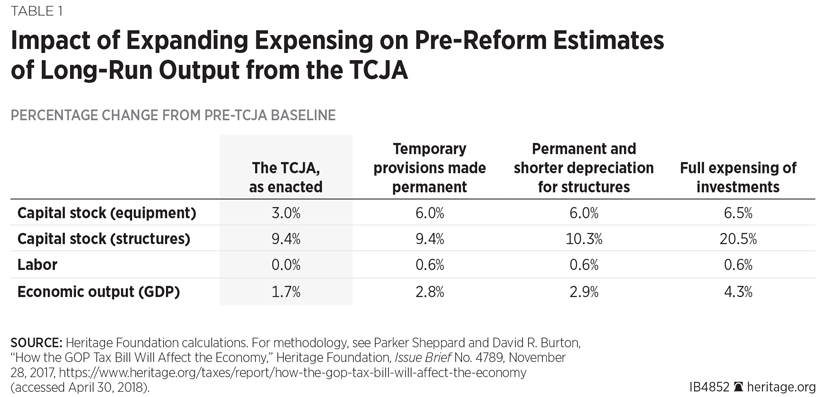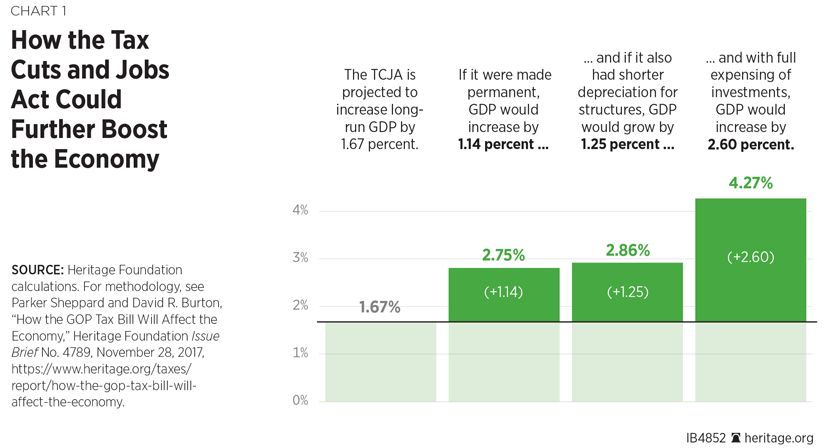The Tax Cuts and Jobs Act of 2017 (TCJA) is projected to increase the long-run size of the U.S. economy by about 2 percent, or about $3,000 per household.REF However, many of the law’s changes are temporary, and, if allowed to expire, the temporary changes will have no effect on the economy in the long run. To realize the remaining benefits of tax reform, Congress should make the new tax law permanent and expand “expensing”—the ability for businesses to write off new investments immediately after they are made.
Expensing and the Definition of Income
Businesses generally pay income taxes on their profits, or revenues minus costs. The costs of employee salaries, power bills, and rent are all deductible in the year they are paid. However, a different set of rules apply to capital investments, such as equipment and structures. Businesses must deduct the cost of investments from their revenue over a set number of years, according to complicated depreciation schedules.
The depreciation schedules exist in order to calculate a corporation’s income according to the Haig–Simons definition, which is the sum of consumption and changes in net worth. A firm that invests in a new factory cannot deduct that expenditure from its taxable income because its net worth (theoretically) has not changed. It only registers the expense for tax purposes as the factory’s value falls each year due to the wear and tear of the production process.
In contrast to existing depreciation schedules, which are the government’s estimate of the wear and tear on capital, full expensing would allow businesses to deduct all investment expenses from taxable income at the time the investments are made. Expensing brings the tax code in line with the Fisher–Ture definition of income, which is gross receipts less current outlays to earn future income.REF
The distinction between the two definitions of income is subtle, but important. The Haig–Simons definition treats all changes in net worth equally, while the Fisher–Ture definition recognizes a distinction between wealth that is held for future spending and wealth that is put to work. By waiting to tax as income only revenues that are meant to be spent on consumption, the Fisher–Ture definition of income provides stronger incentives for individuals to delay consumption in favor of investing. This Issue Brief explains why the Fisher–Ture definition of income is preferable and why the TCJA is to be commended for taking steps toward its adoption.
Key Provisions of the TCJA
The TCJA reduced the federal corporate tax rate from 35 percent to 21 percent and reduced tax rates on pass-through business income reported on personal tax returns. On the personal income side, the law consolidated tax brackets and increased the standard deduction, which simplifies the process of filing a return for the majority of households. However, the income tax rates are only reduced for the first eight years following the law’s implementation.
While the changes in tax rates have received the most attention, the law’s adjustments to expensing rules have equally important economic effects. The TCJA adopts the Fisher–Ture definition of income for most short-lived types of capital, allowing full expensing for items such as equipment and machinery. However, the changes do not apply to structures and are not permanent.REF
Making the TCJA Permanent Increases Gross Domestic Product
Heritage experts projected in a previous report that long-run gross domestic product will increase by 1.67 percent over the pre-reform baseline.REF For this current analysis, we present the estimates relative to the pre-reform baseline to highlight the relative magnitude of the proposed changes and to emphasize that they are provisions that are already included in the TCJA.
Extending the TCJA permanently would increase the size of the economy by 2.75 percent over the pre-reform baseline. Making the TCJA’s temporary provisions permanent is the simplest reform Congress could enact. The temporary provisions have already won approval from lawmakers for the near term. Two additional options to reform the tax code would further raise the level of output.
- A shortened depreciation schedule for structures. Originally included in the Senate bill, the shortened schedule would bring the tax treatment of structures closer in line with the Fisher–Ture definition of income and the treatment for other types of capital. While the shortened depreciation schedule does raise output, we estimate that it would lead to a modest 0.1 percent increase in GDP.
- Full expensing for all investments. Originally included in the House tax reform Blueprint,REF this simple expansion would increase U.S. output by 4.3 percent over the pre-reform baseline, substantially more than the 2.75 percent increase that would occur if the temporary provisions are made permanent.


Additional Benefits Beyond Increased Gross Domestic Product
In addition to the increase in GDP, other benefits will occur that are not captured in the estimates presented above. Moving to full expensing raises wages, reduces mismeasurement of income, simplifies income reporting, reduces market distortions, and eliminates perverse incentives.
Raising Wages. By removing incentives that discourage investing, these proposed changes produce higher wages for workers. Additional capital in the form of new buildings and equipment means that, with each hour of labor, workers produce more goods and more valuable goods and services. Because each hour of labor brings in more revenue for businesses, they want to hire more workers and are able to pay higher wages.
Accurately Measuring Income. Practical issues with measuring changes in net worth come with the implementation of the Haig–Simons definition of income. To illustrate, consider a firm that builds a new factory that costs $1 million. The existing depreciation schedules value that factory for tax purposes at $1 million and only allow its value to fall with the passage of time. Further suppose that the firm needed to sell the factory the day that it opened. The market value of the factory is likely substantially less than $1 million both because it is a specialized type of capital and unlikely to be used exactly as built by another firm and because buyers of secondhand assets run the risk that the asset is for sale because it is defective.REF Depreciation schedules are an approximation, which represents a compromise between accurately recording changes in net worth and minimizing the complexity of measuring and reporting changes in net worth. To the extent that depreciation schedules overvalue assets, they lower the return to capital and discourage investment.
Simplifying Taxpaying. Even with depreciation schedules, the costs associated with tracking changes in net worth is substantial. According to research from the Internal Revenue Service, business tax compliance costs are over $100 billion per year, representing a massive waste of money and effort.REF Considering that compliance costs are equal to 14 percent of total taxes paid by traditional C corporations, the cost of compliance is unacceptably high.REF A 2016 Tax Foundation analysis estimated that businesses spend over $23 billion a year complying with depreciation schedules alone.REF
The real cost of accurately measuring income under the Fisher–Ture definition is substantially lower. Businesses would not have to track investment depreciation schedules or account for uncertain tax costs associated with long write-off periods. Moving to full expensing could redirect the $23 billion expense of complying with depreciation schedules toward productive activities.
Reducing Market Distortions. Unevenly applied tax policy creates new market distortions by favoring one type of capital at the expense of others. Bad policy inserts the tax code into investment decisions and makes production less efficient. For example, the current expensing rules make new equipment, which has a faster depreciation schedule, more attractive than expanding manufacturing floor space, which has a longer depreciation schedule. Firms should choose whether to use equipment or structures on the basis of which type of capital produces the most for the expense, not on which type of capital has the most favorable present-value tax deduction.
Eliminating Perverse Incentives. By putting these changes in place and then taking them away after five or 10 years, Congress has created perverse incentives for businesses. As the expiration date for expensing draws near, businesses will rush to make new investments to take advantage of the temporary rules. Temporary changes have no effect on investment in the long run. They only result in firms bringing some investment forward in time.
Congress generally uses fiscal policy to smooth fluctuations in the business cycle. Yet, the expiring provisions could aggravate business cycle fluctuations. If investment decreases by a substantial amount in the years following expensing’s expiration, it increases the chances of a recession.
Complete the Transition Now
The TCJA is the most important tax reform bill to come through Congress in thirty years, in part because negotiating changes to the United States’ complicated tax code is a tedious process. Congress could pass a law with 60 percent of the benefit of major tax reform by simply making permanent the provisions that lawmakers have already agreed to within a 10-year window. Applying the expensing rules that Congress has agreed to for some types of investment to all investment would follow a major reform bill with another that has 150 percent of the benefit.
The tax code has many areas in need of reform.REF Lawmakers are reticent to start major negotiations on another bill having just passed one major reform and heading into an election. However, by simply expanding and making permanent the changes that Congress has already agreed to in the TCJA, lawmakers could double the benefits of tax reform for their constituents.
—Adam N. Michel is a Policy Analyst in Tax and Budget Policy in the Thomas A. Roe Institute for Economic Policy Studies, of the Institute for Economic Freedom, at The Heritage Foundation. Parker Sheppard, PhD, is Senior Policy Analyst for Dynamic Modelling and Simulations in the Center for Data Analysis, of the Institute for Economic Freedom.



